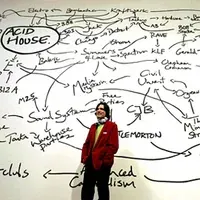The MsBehaviour Files: Mindmaps
Written by

In her first column for The Big Idea, Helen Baxter aka MsBehaviour explores one method of making sense of your 'big ideas': mindmaps.
Image: In his piece History of the World, UK artist Jeremy Deller depicts links between an array of words in an intricate mindmap that aims to demonstrate how 'acid house' is linked to 'brass bands'.In her first column for The Big Idea, Helen Baxter aka MsBehaviour explores one method of making sense of your 'big ideas': mindmaps.
Image: In his piece History of the World, UK artist Jeremy Deller depicts links between an array of words in an intricate mindmap that aims to demonstrate how 'acid house' is linked to 'brass bands'.My best ideas usually come to me when I'm lying flat on my back. In the bath, in bed or on my yoga mat. It seems we are most likely to have a eureka moment when we're laid back and relaxed.
Ideas are great. We get them every day, and mindmaps are a quick, easy way of getting them out of your head and onto paper. I always have a pen and paper by me, to write down ideas and mindmapping helps keep my brain clear and serene.
Wikipedia defines mindmaps as: "a diagram used to represent words, ideas, tasks or other items linked to and arranged radially around a central key word or idea. It is used to generate, visualise, structure and classify ideas, and as an aid in study, organisation, problem solving, and decision making."
Mindmaps are perfect for capturing creative flow as they stop you thinking in a linear fashion. The theory is that scribbling words, colours and images diagramatically uses both the left and right sides of the brain in harmony.
The idea of mapping data has been traced back to the third century, when philosopher Porphyry of Tyre arranged the ideas of Aristotle into a graphical format.
Most modern mindmaps stem from the work of Tony Buzan, who calls them the most powerful "thinking tool" of our times. They are often used by creative people who have Big Ideas, and Time Magazine noted in a recent article that Al Gore uses "Mind Map software and huge Post-it notes help him order his thoughts".
There have been plenty of books published on the subject, but I find they tend to contain too many rules and restrictions. The only rule I agree with is to develop your own personal style of mindmapping. The best way to learn is to grab some coloured pens and paper, lie down, relax and start scribbling.
As I always try to practice what I preach, this column started out as a mindmap which looks like this.
How to draw a mindmap
1. Start in the centre of your page, and pick a word that defines your central topic.
2. Quickly add branches and sub branches of associated thoughts and ideas.
3. Don't agonise about the words just get them down. You can edit later.
4. Go wild with coloured pens and doodles.
5. Have fun and enjoy yourself.
Keep writing until you are creatively sated. Then put the pen down, and go and do something completely different. You can revisit your mindmap later to turn your ideas into lists, for the Getting Things Done stage of the innovation process.
Mindmapping tools
Once you've used paper to create your mindmap, you can move to pixels to share and collaborate. My current favourite mindmapping tool is Mindmeister which I used to draw the Mindmap above. Mindmeister is a Webtop application that runs in your browser. It's simple, quick and free for up to six maps, and you can share maps to collaborate online in real time. Other good mindmapping tools are Freemind which is Open Source and therefore free. There are also some exciting new tools such as Topicscape that produce 3D Mindmaps.
Wikipedia has a great list of Mindmapping software, and you now can even browse Wikipedia content as mindmaps. I particularly love the Wikipedia mindmap on Creativity. There is also some fantastic examples of colourful creative mindmaps on a whole range of subjects at the Mindmaps Directory.
It's hard to believe that something so simple can be so useful. I use mindmaps in all areas of my creative business, such as planning articles and radio shows, mapping website content or planning gigs and promotions. I have even used them to plan interior decorating, or sketching out a menu for a dinner party. You can draw a mindmap for pretty much anything. So pick a topic, any topic and get scribbling!
7/6/07
As well as being TBI's strategist, Helen Baxter runs dance-music label TMet Recordings, 3D animation company Mohawk Media and has a fortnightly slot on National Radio called 'Virtual World'.